Introduction
Scorpions are arthropods of medical importance classified in the Class Arachnida, inhabiting hot and dry environments. All scorpions have a venomous sting and several thousand people die each year from scorpion stings, but this mortality is due to the venom of about 25 species located in northern Africa, the Middle East, India, Mexico and parts of South America [1,2].
The dangerous consequences of the scorpion stings comprised the severe and lethal haemolysis, acute renal failure, deep necrotic wound, severe joint inflammation, temporary and permanent psychosis and death. The highest mortality due to scorpion stings are associated with Hemiscorpius lepturus (Peters, 1861) in Iran [3].
Scorpions are terrestrial arthropods exhibiting a non-social and nocturnal habit, in which their existence dates back to over 360 million years ago, during the Silurian era [4-6]. As a result, they have acquired various degrees of adaptations to different ecological conditions in the course of their natural histories [6,7]. Scorpions are arthropods of medical importance classified in the Class Arachnida, inhabiting in hot and dry environments [8]. Geographically, scorpion distribution ranges from tropical to temperate regions, including deserts, savannas, tropical forests, mountains exceeding 5500 m high in altitude and the intertidal zone [2,9].
Scorpions normally appear after sunset, are hidden during the day under rocks or within burrows [10]. Number of scorpion have potent venomous stinging characteristics, but do not serve as reservoirs or vector of disease [10,11].
Significantly, numerous studies have described the persistent severity of scorpion envenomation, predominantly in the Central and Southern America, North Africa, the Middle East and Southwestern Asia [11,12]. Remarkably, over 2000 scorpion species have been described and identified [13].
Primarily, scorpion fauna in Iran was first explored by Olivier and he identified the black scorpion, Androctonus crassicauda, in Kashan [8]. Following this, other profound investigators, including a Russian zoologist, Alexei Andreevich Byalynitskii-Birulya, have published a vast number of reports detailing the presence of scorpions in Iran [14-16]. According to well-established scientific reports, there are a minimum of 51 species of scorpions in Iran, belonging to 18 genera and 4 families namely Diplocentridae, Scorpionidae, Hemiscorpiidae and Buthidae [15-17].
Annually, it is estimated that nearly 40000-50000 people are stung by different species of scorpions in Iran [18,19]. The three main species of scorpions with economic importance as a result of their severe envenomation include M. eupeus, A. crassicauda and Hemiscorpius lepturus. However, other species of secondary importance encompass Hottentota (Buthotus) saulcyi, Odontobuthus doriae, Olivierus (Mesobuthus) caucasicaus and Apistobuthus pterygosercus [20].
Clinical symptoms designating scorpion sting cases include, but not limited to, tachypnea, tachycardia, hemolysis, pulmonary edema, agitation, intensive local pain, necrosis and sweating [21]. Children are the most vulnerable group of people in situations of severe scorpion envenomation and this has given rise to a greater number of deaths in this age group [22].
The absence of epidemiological data on scorpion fauna and scorpionism has led to the failure of most control strategies for different species of scorpion, because habitat of scorpions is different such as digger scorpions, half-digger scorpions and non-digger scorpions.
Poldokhtar County belongs to one of the southern cities of Lorestan Province, providing suitable habitats for many different species of scorpions due to its specific climatic conditions and there are many reports of scorpion stings in this area [17]. In spite of this, no general and extensive study regarding scorpions has been conducted so far within the city.
This present study aimed to examine the fauna of scorpion and its distribution in the Poldokhtar County. In effect, this has a long term strategic plan for the reduction and elimination of scorpion sting cases among the susceptible residents of these regions.
Materials and Methods
Study Area
This present study was a descriptive and analytical cross-sectional study conducted from April to November 2014 in regions of Poldokhtar County, Lorestan Province, and Western Iran. Poldokhtar County belongs to geographic coordinates of 33°10’ North and 48°00’ East [Table/Fig-1]. Poldokhtar has been designated as the capital city of the county. As at 2014 population census, Poldokhtar County has accommodated closely 86,693 inhabitants, including 20,508 families. The county is subdivided into two districts and two cities; the Central District, with its city of Poldokhtar, and the Mamulan district enclosing the Mamulan city.
Location of study area in Poldokhtar County, Lorestan Province, western Iran [1].
1https://www.alltravels.com/iran/lorestan/pol-dokhtar/maps
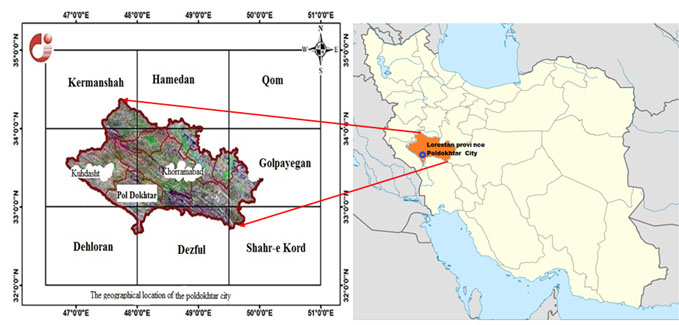
Sampling and Scorpion Collection
Cluster sampling methodology was employed in the sampling and scorpion collection procedure. Scorpions were collected by researchers and indigenous people. Sampling was undertaken for an eight-month period, in villages and districts, namely, Myankuhe sharqi, Jayedar, Jelogir and Malavi within the county.
Collection of scorpions was done at night and examined using the Ultra Violet (UV) light [Table/Fig-2], holding it at an interval of about 20 cm from the ground, on brick walls or muddy walls. Meanwhile, during the day, scorpions were collected via digging, rock-rolling, searching of gaps in backyard gardens near houses, pouring water in holes, searching lower sections of tree trunks and pulling down ancient walls. Scorpions were eventually gathered by using the forceps, and then transferred to the laboratory in separate glass containers containing 70% alcohol [Table/Fig-3]. Necessary data concerning the scorpions, which include the place of abode and date of collection, were recorded.
Hunted scorpions under ultraviolet light (by Rastgar H.).
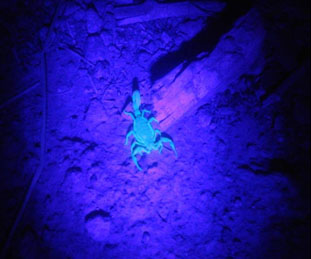
Glass storage collected of scorpions.
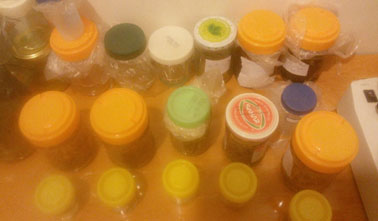
Scorpion Species Identification
Morphological identification was finalized following observation under a stereo microscope using specific diagnostic keys. The Iranian scorpion species were identified by conforming to the Farzanpay’s key of identification [8,17]. The basis of identification in these keys are the comparison between the morphological features of scorpions, such as the number of eyes, the sternum figure, tongs forms, the number and pattern of granules on the body, color and etc. The genera of scorpions were identified by the position of shoulder taps and the number of teeth.
Statistical Analysis
The Chi-square test and the Fisher-exact test for homogeneity of proportions were used to compare quantitative variables. Confidence intervals (CI) of 95% for prevalence were determined. The statistical analysis was conducted with SPSS (ver. 20) statistical software. The p-values of 0.05 or less were considered statistically significant.
Results
Totally, 393 specimens were captured entailing 193 (49.1%) males and 200 (50.9%) females. There were at least seven species of scorpions belonging to three families; BU=Buthidae, HE=Hemiscorpiidae, SCN=Scorpionidae in Poldokhtar. Out of 393 collected scorpions, seven species, Androctonus crassicauda, Hottentotta (Buthotus) saulcyi, Compsobuthus matthiessen, Compsobuthus rugosulus, Orthochirus scrobiculosus, Scorpio maurus and Hemiscorpius lepturus were identified [Table/Fig-4,5] [23].
The abundance of captured scorpions according to family, species and sex in Poldokhtar County, western Iran (2014).
| Family | Species | SexNo. (%) | TotalNo. (%) |
|---|
| MaleNo. (%) | FemaleNo. (%) |
|---|
| Buthidae (C.L. Koch,1837) | H. saulcyi | 69 (48.3) | 74 (51.7) | 143 (36.4) |
| A. crassicauda | 27 (48.2) | 29 (51.8) | 56 (14.2) |
| O. scrobiculosus | 8 (57.1) | 6 (42.9) | 14 (3.6) |
| C. matthiesseni | 2 (66.7) | 1 (33.3) | 3 (0.8) |
| C. rugulosus | 7 (43.8) | 9 (56.2) | 16 (4.1) |
| Scorpionidae (Latreille, 1802) | S. maurus | 65 (48.5) | 69 (51.5) | 134 (34.1) |
| Hemiscorpiidae (Pocock, 1893) | H. lepturus | 15 (55.6) | 12 (44.4) | 27 (6.9) |
| Total | | 193 (49.1) | 200 (50.9) | 393 (100) |
Family and species same as mentioned by Kassiri et al [23].
Morphological characters of scorpions (dorsal view) captured in Poldokhtar County, western Iran (2014): (A) Hottentota (Buthotus) saulcyi: (B) Androctonus crassicauda; (C) Orthochirus scrobiculosus; (D) Compsobuthus matthiesseni; (E) Compsobuthus rugulosus; (F) Scorpio maurus; (G) Hemiscorpius lepturus; (Original photos by H. Rastgar).
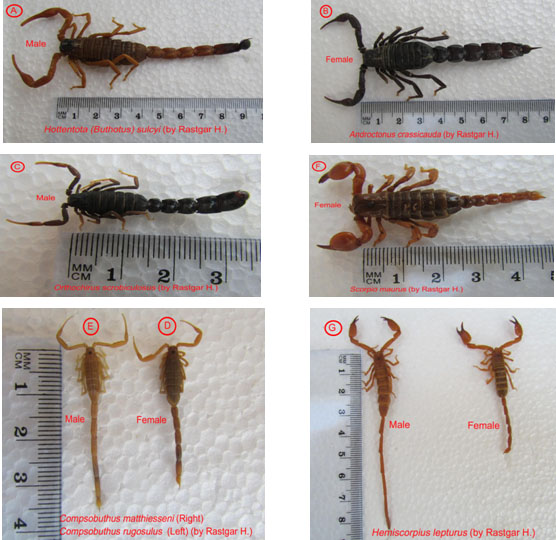
Buthotus sulcyi, consisting of 143 (36.4%) scorpions, was the most frequently recorded and dominant species. In contrast, Compsobuthus matthiesseni, involving 3 (0.8%) scorpions, had the least frequency (p<0.01, χ2 =368, 11, df=6). The overall sex ratio of females to males was 1:1.03.
Sixty nine hunted scorpions (17.5%) recorded from the Sarab Hamam area had the highest frequency, and records from the Sarab Abdolali with 13 hunted scorpions (3.3%) had the lowest frequency [Table/Fig-6]. The frequencies of captured scorpions were in the villages of Sarab Hamam (69, 17.5%), Valiasr (19, 4.8%), Chalkal (27, 6.9%), Chamgaz (24, 6.1%), Absard (20, 5.1%), Dadagolab (14, 3.5%), Sarab Abdolali (13, 3.3%), Dareh Shoor (40, 10.2%), Bagh Golgol (53, 13.5%), Golgol (29, 7.4%), Chamgardeleh (51, 13%), and Meidan (34, 8.7%), respectively. The variation between the absolute and relative frequencies of captured scorpions in Poldokhtar in terms of species richness in the regions under study in 2014 was statistically significant (p<0.01, χ2 =375, 55, df=66).
Distribution of scorpion species in different major areas of Poldokhtar County, western Iran 2014.
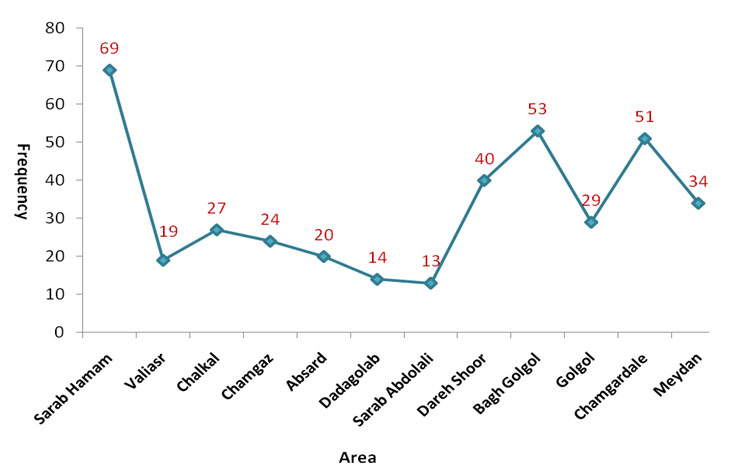
The highest and the lowest frequencies of the hunted scorpions were 87 (22.1%) in August and 14 (3.5%) in November, respectively [Table/Fig-7]. There was statistically significant difference between months of scorpion collection in Poldokhtar in 2014, (p<0.01, χ2 =73, 13, df=42).
Monthly fluctuation of the scorpions found in Poldokhtar County, western Iran (2014).
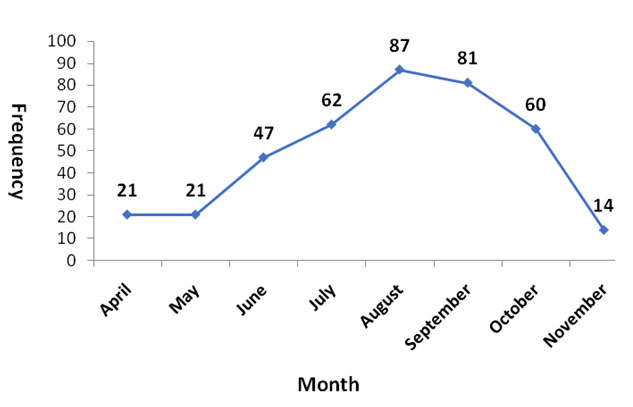
Discussion
Scorpion envenomation commonly occurs in the tropical and sub-tropical regions, as a challenging medical situation in Iran [12,24]. Scorpionism remains a serious health problem in several southern parts of Iran. Iran, with nearly 10 venomous scorpion species, has the largest number of scorpions among other Middle Eastern countries [10,13,15]. This research demonstrated a wide diversity of scorpion species in the Poldokhtar County, consisting of three families of scorpions, namely, BU, HE, SCN with at least seven species and subspecies. According to current study, Androctonus crassicauda (Olivier, 1807), Hottentotta saulcyi (Simon, 1880), Compsobuthus matthiesseni (Birula, 1905), Compsobuthus rugosulus (Pocock, 1900), Orthochirus scrobiculosus (Grube, 1873), Scorpio maurus (Pocock, 1900) and Hemiscorpius lepturus (Peters, 1861) have been reported from Poldokhtar County [8].
Survey of Nazari et al., showed that in Hamadan 4 species of scorpion named Mesobuthus eupeus (89.7%), Androctonus crassicauda (4.08%), Odontobuthus doriae (5.1%) and Razianus zarudnyi (1.02%) (Family: Buthidae), were identified [24]. Also, Nazari and Hajizadeh were captured 4 species of scorpion from different areas of Bam belonged to the Buthidea family, namely Mesobuthus eupeus (73.1%), Orthochirus zagrosensis (23.8%), Androctonus crassicauda (1.8%) and Compsobuthus kaftani (1.3%) [19].
In the study of Navidpour et al., 18 species of scorpions belonging to three families from the Fars Province of Iran have reported as follows: Androctonus crassicauda, Compsobuthus persicus, C. matthiesseni, Compsobuthus petriolii, Hottentotta saulcyi, Hottentotta schach, Hottentotta zagrosensis, Iranobuthus krali, Mesobuthus eupeus persicus, Mesobuthus phillipsii, Odontobuthus bidentatus, O. doriae, Orthochirus farzanpayi, Orthochirus zagrosensis, Razianus zarudnyi, S. maurus townsendi, H. lepturus and Hemiscorpius sp [25].
The Scorpio maurus was the first identified and reported species in the city. Previously, some studies, conducted in the Kerman Province, Androctonus crassicauda have been discovered and identified, together with other species of Compsobuthus and Orthochirus [16].
The Hemiscorpius lepturus, which is the most dangerous scorpion in southern Iran. Dispersion of this species affected by the type of soil and its humidity, topographic condition and climate. The victim of scorpion sting was stung by H. lepturus, while a few were stung by A. crassicauda, but in over half of the cases the species was not known in southern and southwestern parts of Iran [3]. In this study, the prevalence of Hemiscorpius lepturus was 6.9%. The prevalence of H. lepturus in Khuzestan, Kerman, Hormozgan and Ilam provinces were 24.9%, 0.9%, 21.6% and 5.56%, respectively [26-28]. Other studies revealed that H.lepturus was responsible for 90% of deaths in the southern provinces of Iran [27,28]. H. lepturus also is dangerous species in Iraq, Pakistan and Yemen [29,30].
It must be emphasized that Buthotus sulcyi, consisting of 143 (36.4%) scorpions, was considered as the dominant species in the city. These species are more prominent in this area because of its suitable climatic conditions [15,29]. However, Campsobuthus matthiesseni (3, 0.8%) was the least recorded species in the county, probably due to their inability to adapt to the climatic conditions of Poldokhtar County.
Females were frequently recorded than their counterpart males with a sex ratio of 1:1.03. Perhaps, males were more obscure and could not be traced and caught during the collection procedure.
Varying records among the different species of scorpions were statistically significant considering the months of the study period, with a noticeable peak in July, and a decline in October. Differences in monthly records of the species were due to seasonal variations. In summer, when the weather is relatively warm, many species of scorpions are active and normally emerge at night in search of food and victims. These results are consistent with the results of other studies performed in Turkey [11] and Saudi Arabia [31], where the highest number of scorpions was recorded in the warmer summer.
Preventive and Medical Interventions in Combating Scorpionism
The control of scorpion must focus on preventing the contact between humans and scorpions and the reduction of the number of scorpions. These can be done through: active search and collect or killing of the scorpions, the use of chemicals, introduction of natural predators, environmental-architectonic measures or, depending the situation, through combinations of the former [32].
The appropriate treatment of scorpion envenoming is argumentative. Some authors do recommend the use of the scorpion antivenom [33-36], while other authors consider that the use of specific antivenom unnecessary [37-40]. However, in a recent study it was demonstrated that the use of antivenom is more effective than the pharmacological treatment alone to treat the envenomation by Centruroides [41].
Most of the scorpions in Iran and other parts of the world have neurotoxic poisons; therefore unrestrained knowledge of Avicenna could be useful for the researchers and physicians in tropical and semitropical areas. According to another study, each patient is treated individually in traditional medicine because their temperament is a mixture of four humors and the balance is different from one person to another [12].
Conclusion
It is crucial to improve the knowledge of residents in this region regarding preventive methods towards scorpion stinging. All the known dangerous Iranian scorpions having medical importance, including H. lepturus and Androctonus crassicauda were found in the study area. Additionally, other complementary research detailing the fauna of scorpions and their morphological, ecological and molecular variety in this region is highly recommended to estimate the correlation between particular scorpions’ species and ensuing clinical signs and symptoms. Poldokhtar County, with its tropical and subtropical climate is an endemic foci of scorpionism. Also, this area is relatively undiscovered in terms of scorpion species composition. This research presents novel formal data illustrating scorpion fauna in this vulnerable region.
Funding/Support: The study was funded by Vice-chancellor for research and Technology, Hamadan University of Medical Sciences (No. 9307293688).
Family and species same as mentioned by Kassiri et al [23].
[1]. Keegan HL, Scorpions of medical importance 1980 University Press of Mississippi [Google Scholar]
[2]. Polis GA, The biology of scorpions 1990 Stanford University Press [Google Scholar]
[3]. Mohseni A, Vazirianzadeh B, Hossienzadeh M, Salehcheh M, Moradi A, Moravvej SA, The roles of some scorpions, Hemiscorpius lepturus and An-droctonus crassicauda, in a scorpionism focus in Ramhormorz, southwestern IranJournal of Insect Science 2013 13(1):89 [Google Scholar]
[4]. Lourenco W, The scorpion families and their geographical distributionJournal of Venomous Animals and Toxins 2001 7(1):03-23. [Google Scholar]
[5]. Fet V, Soleglad ME, Contributions to scorpion systematics. I. On recent changes in high-level taxonomyEuscorpius 2013 2005(31):1-13. [Google Scholar]
[6]. Navidpour S, Vazirianzadeh B, Mohammadi A, Burrowing activities of Scorpio maurus towensendi (Arachnida: Scorpionida: Scorpionidae) in province of Khouzestan sw Iran 2015 [Google Scholar]
[7]. Hadley NF, Adaptational biology of desert scorpionsJournal of Arachnology 1974 :11-23. [Google Scholar]
[8]. Farzanpay R, [A catalogue of the scorpions occurring in Iran, up to January 1986]Archives de l’Institut Razi (Iran Islamic Republic) 1990 [Google Scholar]
[9]. Zarei A, Rafinejad J, Shemshad K, Khaghani R, Faunistic study and biodiversity of scorpions in Qeshm Island (Persian Gulf)Journal of Arthropod-Borne Diseases 2009 3(1):46 [Google Scholar]
[10]. Nejati J, Mozafari E, Saghafipour A, Kiyani M, Scorpion fauna and epidemiological aspects of scorpionism in southeastern IranAsian Pacific Journal of Tropical Biomedicine 2014 4:S217-S21. [Google Scholar]
[11]. Ozkan O, Adiguzel S, Yakistiran S, Cesaretli Y, Orman M, Karaer KZ, Androctonus crassicauda (Olivier 1807) scorpionism in the Sanliurfa provinces of TurkeyTurkiye Parazitol Derg 2006 30(3):239-45. [Google Scholar]
[12]. Dehghani R, Arani MG, Scorpion sting prevention and treatment in ancient IranJournal of Traditional And Complementary Medicine 2015 5(2):75-80. [Google Scholar]
[13]. Navidpour S, Ezatkhah M, Kovařík F, Soleglad ME, Fet V, Scorpions of Iran (Arachnida: Scorpiones). Part VII. Kerman ProvinceEuscorpius 2011 2011(131):1-32. [Google Scholar]
[14]. Fet V, Braunwalder ME, The scorpions (Arachnida: Scorpiones) of the Aegean area: current problems in taxonomy and biogeographyBelgian Journal of Zoology 2000 130(Suppl 1):17-22. [Google Scholar]
[15]. Sari A, Hosseinie S, History of study and checklist of the scorpion fauna (Arachnida: Scorpiones) of IranProgress in Biological Sciences 2011 1(2):16-23. [Google Scholar]
[16]. Navidpour S, An annotated checklist of scorpions in south and southwestern parts of IranIJFBS 2015 2(3):9-15. [Google Scholar]
[17]. Mirshamsi O, Sari A, Elahi E, Hosseinie S, Mesobuthus eupeus (Scorpiones: Buthidae) from Iran: A polytypic species complexZootaxa 2011 2929:1-21. [Google Scholar]
[18]. Shahi M, Azizi K, Ansarian N, Study on scorpions fauna in high risk area of Hormozgan province, 2006-7Bimonthly Journal of Hormozgan University of Medical Sciences 2009 12(4):207-14. [Google Scholar]
[19]. Nazari M, Hajizadeh M, A faunistic study on scorpions and the epidemiology of scorpionism in Bam, Southeast of IranGlobal Journal of Health Science 2016 9(2):177 [Google Scholar]
[20]. Dehghani R, Moabed S, Kamyabi F, Haghdoost A, Mashayekhi M, Soltani H, Scorpions fauna of Kerman province-IranJournal of Kerman University of Medical Sciences 2008 15(2):172-81. [Google Scholar]
[21]. Shahbazzadeh D, Amirkhani A, Djadid ND, Bigdeli S, Akbari A, Ahari H, Epidemiological and clinical survey of scorpionism in Khuzestan province, Iran (2003)Toxicon 2009 53(4):454-59. [Google Scholar]
[22]. Dehghani R, Valaie N, The review of classification of scorpions and their diagnostic key of Iran scorpionsFeyz Journal 2004 8(32):62-84. [Google Scholar]
[23]. Kassiri H, Kasiri N, Dianat A, Species composition, sex ratio, geographical distribution, seasonal and monthly activity of scorpions and epidemiological features of scorpionism in Zarrin-dasht County, Fars Province, Southern IranAsian Pac J Trop Dis 2015 5(Suppl 1):S99-S103. [Google Scholar]
[24]. Nazari M, Bahrami D, Davari B, Salehzadeh A, Epidemiological survey of scorpion sting cases and identification of scorpion Fauna in Hamadan City, Iran (2013)Scientific Journal of Hamadan University of Medical Sciences 2015 22(3):255-62. [Google Scholar]
[25]. Navidpour S, Fet V, Kovařík F, Soleglad ME, Scorpions of Iran (Arachnida, Scorpiones). Part VIII. Fars ProvinceEuscorpius 2015 2012(139):1-29. [Google Scholar]
[26]. Dehghani R, Djadid ND, Shahbazzadeh D, Bigdelli S, Introducing Compsobuthus matthiesseni (Birula, 1905) scorpion as one of the major stinging scorpions in Khuzestan, IranToxicon 2009 54(3):272-77. [Google Scholar]
[27]. Pipelzadeh MH, Jalali A, Taraz M, Pourabbas R, Zaremirakabadi A, An epidemiological and a clinical study on scorpionism by the Iranian scorpion Hemiscorpius lepturusToxicon 2007 50(7):984-92. [Google Scholar]
[28]. Mozaffari E, Sedaghat MM, Dehkordi AS, Akbarzadeh K, Biodiversity and species composition of scorpions (Arachnida, Scorpiones) in Ilam County, IranJ Appl Sci Res 2013 9(9):5412-18. [Google Scholar]
[29]. Rein J, The scorpion filesNorwegian University of Science and Technology 2009 Available at: http://www ub ntnu no/scorpion-files [Google Scholar]
[30]. Nazari M, Saidijam M, Pediculus capitis infestation according to sex and social factors in Hamedan-IranPakistan Journal of Biological Sciences: PJBS 2007 10(19):3473-75. [Google Scholar]
[31]. Jarrar B, Al-Rowaily M, Epidemiological aspects of scorpion stings in Al-Jouf province, Saudi ArabiaAnnals of Saudi medicine 2008 28(3):183 [Google Scholar]
[32]. de Roodt AR, Comments on environmental and sanitary aspects of the scorpionism by Tityus trivittatus in Buenos Aires City, ArgentinaToxins 2014 6(4):1434-52. [Google Scholar]
[33]. Ghalim N, El-Hafny B, Sebti F, Heikel J, Lazar N, Moustanir R, Scorpion envenomation and serotherapy in MoroccoThe American Journal of Tropical Medicine And Hygiene 2000 62(2):277-83. [Google Scholar]
[34]. Ismail M, The treatment of the scorpion envenoming syndrome: the Saudi experience with serotherapyToxicon 1994 32(9):1019-26. [Google Scholar]
[35]. Freire-Maia L, Campos J, Amaral C, Approaches to the treatment of scorpion envenomingToxicon 1994 32(9):1009-14. [Google Scholar]
[36]. Osnaya-Romero N, de Jesus Medina-Hernández T, Flores-Hernández S, Leon-Rojas G, Clinical symptoms observed in children envenomated by scorpion stings, at the children’s hospital from the State of Morelos, MexicoToxicon 2001 39(6):781-85. [Google Scholar]
[37]. Gueron M, Ilia R, Sofer S, The cardiovascular system after scorpion envenomation. A reviewJournal of Toxicology: Clinical Toxicology 1992 30(2):245-58. [Google Scholar]
[38]. Abroug F, ElAtrous S, Nouria S, Haguiga H, Touzi N, Bouchoucha S, Serotherapy in scorpion envenomation: a randomised controlled trialThe Lancet 1999 354(9182):906-09. [Google Scholar]
[39]. Sofer S, Shahak E, Gueron M, Scorpion envenomation and antivenom therapyThe Journal of Pediatrics 1994 124(6):973-78. [Google Scholar]
[40]. Gueron M, Sofer S, The role of the intensivist in the treatment of the cardiovascular manifestations of scorpion envenomationToxicon 1994 32(9):1027-29. [Google Scholar]
[41]. Boyer LV, Theodorou AA, Berg RA, Mallie J, Chávez-Méndez A, García-Ubbelohde W, Antivenom for critically ill children with neurotoxicity from scorpion stingsNew England Journal of Medicine 2009 360(20):2090-98. [Google Scholar]